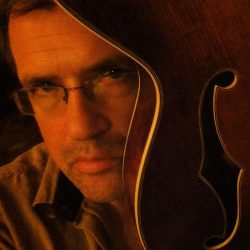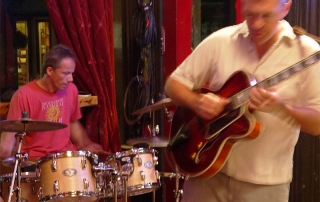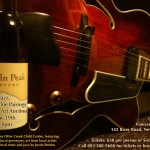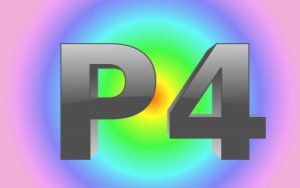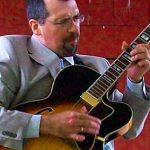This piece has recently evolved from a more Trane Quartet-type of modal tune (over a pedal tone, a la the beginning of “Spiritual”) to something with a more eastern feel. I’d been using a standard, clean jazz guitar tone with Travis playing in more of an Elvin vein on the full kit. Jeremy started using slide on the bass and a an old Mu-Tron envelope filter for this, and that opened things up a bit in terms of timbre… I’m playing guitar synthesizer sitar sound here, with Travis playing Egyptian tabla. This was our first time playing the tune with this instrumentation/orchestration, recorded live at Langdon St. Cafe, 7/15/2010 (though unfortunately cut-off after a few minutes when camcorder battery ran out).
The melody figure vexed me for some time: while harmonically simple, it shifts tonalities over the G/C pedal tones towards the end (introducing Bb and Eb into a C major tonality), and I found the using standard and Lydian chordmodes based on this for improvisational development of the melody wasn’t really sustaining the mood of the piece. After revisiting Yusef Lateef’s brilliant “Repository of Scales and Melodic Patterns” book to work on some Indian and Japanese scales, I realized that several of these were a perfect fit for this tune. The Indian Todi scale (C-Db-Eb-F#-G-Ab-B) and Japanese Naka Zora (B-C-E-F#-G-B) and Kumoi (C-D-Eb-G-A) scales – which are both really partial subsets of Todi – allowed me to explore the relationship between the E/Eb fulcrum and initial CM7 arpeggio of the melody, and created some intriguing tensions over the pedal tone. Coincidentally, I’d also started playing around with the guitar synth again for the first time in years, and this all seemed to fit together nicely: really getting at the sound I’d been hearing for this tune.
Although this excerpt only features synthetic sitar, the overall form returns to a standard guitar tone after this eastern section.

